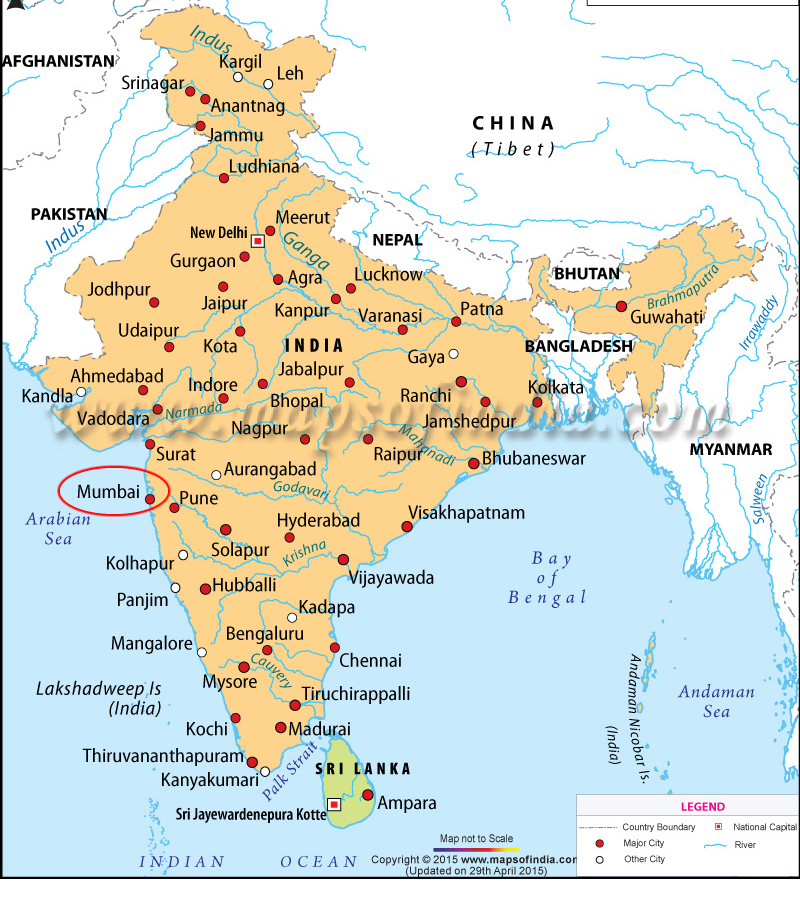India, Mubai March 18
There are 30,000 years of history in India…most of which is of interest only to the anthropologists. The city, we visited, Mumbai, was once called Bombay. In 1995 the name was changed because that is closer to how the inhabitants pronounced Bombay. However, the older residents still refer to it as Bombay. It is India’s most populous city with an estimated population of over 20 million and the richest.
I realize that saying you have visited India when your only port of call is Mumbai is like saying that you have visited the U.S. when you only visited the Statue of Liberty. India is a big country with many different areas, and dialects whose people do not always get along.
But Mumbai is what I can tell you a little about. It is BIG, has traffic that makes New York look like the streets are deserted, is exotic, messy, busy, and has its own blend of Hindu and Moslem architecture – often in the same building, and other assorted oddities. Below is a picture of the skyline of a small part of the city as seen from the Queen's Necklace Road around the Bay.
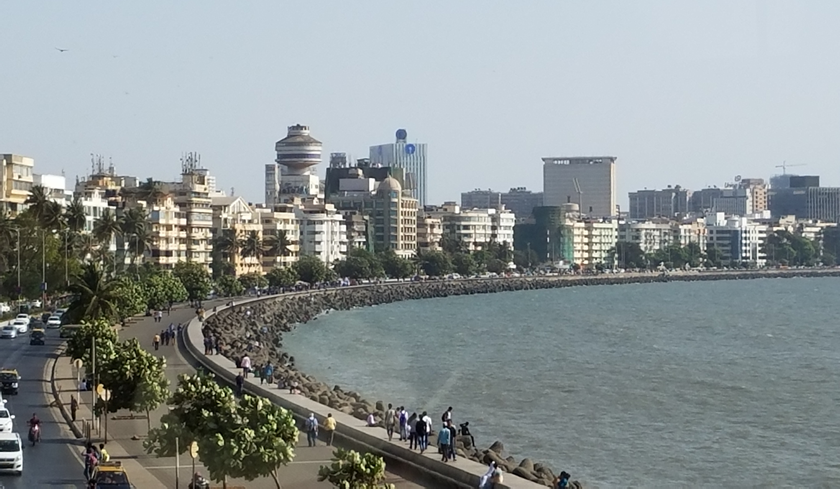
Mumbai, today a peninsular city, was once 7 separate islands of fishing villages. For many centuries, they were under the control of successive indigenous empires. They were eventually ceded to the Portuguese who in 1661 gave them to the British as a dowry when the Portuguese Catherine of Braganza married the English King Charles II. The King promptly turned them over to the British East India Company.
By 1782, the British had used land reclamation, and bridges to unite these islands into one peninsula. In the early, mid 18th century, an English man, Hornby Vellard, supervised the construction of major roads and railways, plus a reclamation project, which was completed in 1845. This transformed Bombay into a major seaport on the Arabian Sea. Today, Mumbai has the highest number of billionaires and millionaires among all cities in India.
Most of us remember when Britain in 1947 granted India independence and there was a forced movement of Hindus to India and Muslims to Pakistan with many deaths. What few of us know is that when India was given independence, Portugual, who had had possession of Goa for centuries (an area south of Mumbai, refused to grant independence. In the 1960s, the Indians got tired of this and simply invaded and made it part of India.
As we were progressing down the harbor toward our mooring, I saw a freighter anchored with two barges rafted alongside. A crane was hauling coal out of the hold of the freighter and dumping it onto the barges. I also saw many small pleasure boats, some sail boats, in one area.
One of the best things that Britain did for India was to build railroads. Mumbai is full of trains – particularly passenger trains. Despite all these trains, there was not one place where there was a railroad crossing the road. Even on the week-end (we were there on a Sat and Sun) there were very frequent trains. We did not see one of the trains that one pictures when one thinks about India, that is packed inside and on top. But one or two were pretty packed in the main cabin.
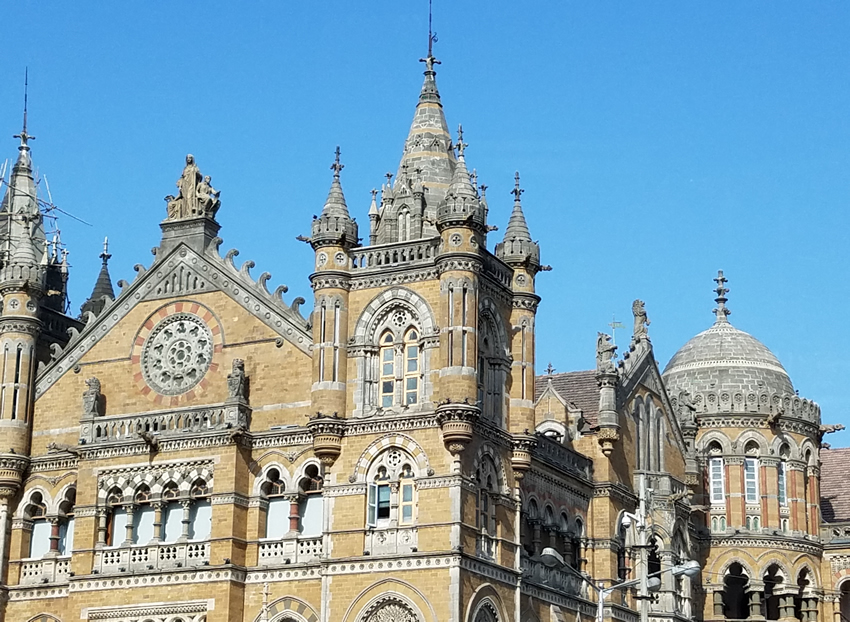
The above pictures about 1/3 of the train station built in the 1800s. The rest is just as ornate as this. The first train from Mumbai left from here and this station is still a very important part of Mumbai transportation.
Cricket is extremely popular, and in at least one section of the city are what looks likes miles of cricket fields. On a visit to the slum Dharavi (much more on that later), a group of 5 pre-school boys, about ages 3 to 6, were playing at cricket. I can still see one little boy in the stance that must be familiar to him from watching tv and probably real cricket games, with his bat down waiting for his friend to throw the ball. Sorry, no picture, we were not allowed to take pictures there.
Theoretically we were to arrive in Mumbai at 8A, but that changed to 10A. And because a much bigger ship was doing a complete passenger switch at the terminal we were sent to the freighter port, where the port people who knew for 3 days that we were coming, took their time bringin a gangway. (We carry our own, but they had to have theirs.) Like bureaucrats everywhere, to demonstrate their power, immigration decided that they did not need to hurry to board and get us checked in. It was 12:30 before we got off the ship for a tour scheduled to start at 9A…
Once off the ship it was a 20 minute bus journey to the “Green Gate” which marked the entry to this cargo port. At that point the bus was stopped, and an official came aboard to check our yellow immigration cards (which had been given us in the lenghty immigration process on the ship) which had been checked as we left the gangway. All he did was look to see if we had one in hand. But he did check the cargo hold of the bus. On the second day, not only did we have to show our yellow cards while on the bus, but get off the bus, show our yellow card again, and have our bags go through an x-ray which no one was watching. Returning we had to do the same procedure. I guess that it was a slow day. The second day I had to work hard to keep from laughing when I was at the bottom of the gangway and this officer took my photo ID, my yellow card and studied them for a full minute – looking at nothing, but trying to be important. I know they have security problems, but common sense might yield higher returns. However, several guides told us that the job of government is to find jobs for the people, so...
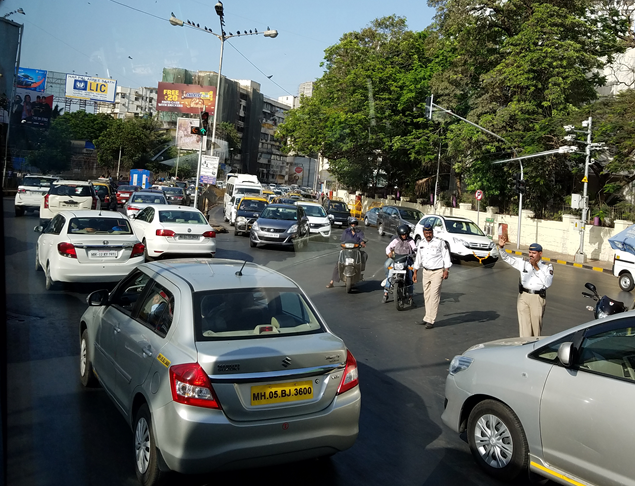
Back to the first day’s tour. The picture above does not do justice to the traffic. Usually one can see bumper to bumper for four lanes on each side, and hears constant horn blowing.
After leaving the green gate we were driven through the old Victorian Area. The beauty of those buildings is overwhelming. They combine Hindu, Muslim, and Victorian architecture into beautiful structures. Unfortunately for those of us who would like to have taken pictures, the road was lined with old, tall, trees blocking the view. What you see here is the best of my ability. Even from a sidewalk one would not have been able to get far enough away with an unobstructed view to do justice to these buildings.
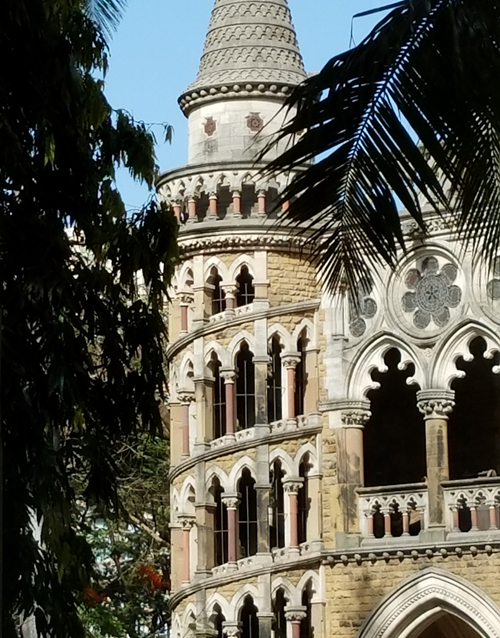
Off to the Gateway to India, the arch built at the end of the peninsula in 1911 to commemorate the visit of George V and Queen Mary. When colonialism ended, the last British ship that left India departed from the area of the Arch. Here we played, “stop and click.”
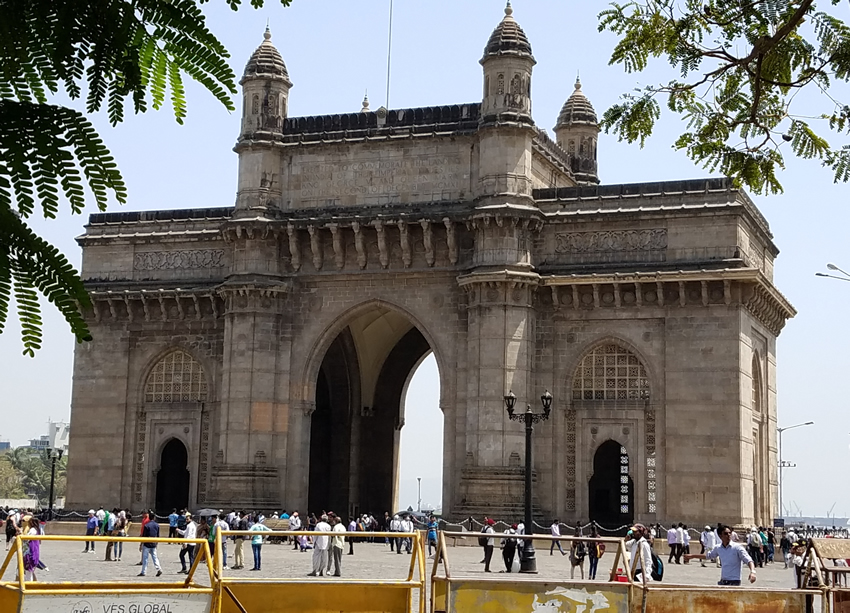
Right next door is the famous Raj Hotel, which was attacked in the Thanksgiving Massacre in 2008. It is also the birthplace of the gin and tonic. This hotel is owned by Mr. Tata, arguably one of the richest men in the world. He owns and manages Tata industries which among other businesses makes Tata cars which are exported as well as being used here. The hotel was built during the 20s by either his father or grandfather who, being Indian, could not be admitted to the Watson Hotel, then the favorite of the Brits. The Raj was so grand, that the British soon came there, and left the Watson a very small remaining clientele. (See the picsture below, it still looks the same.)
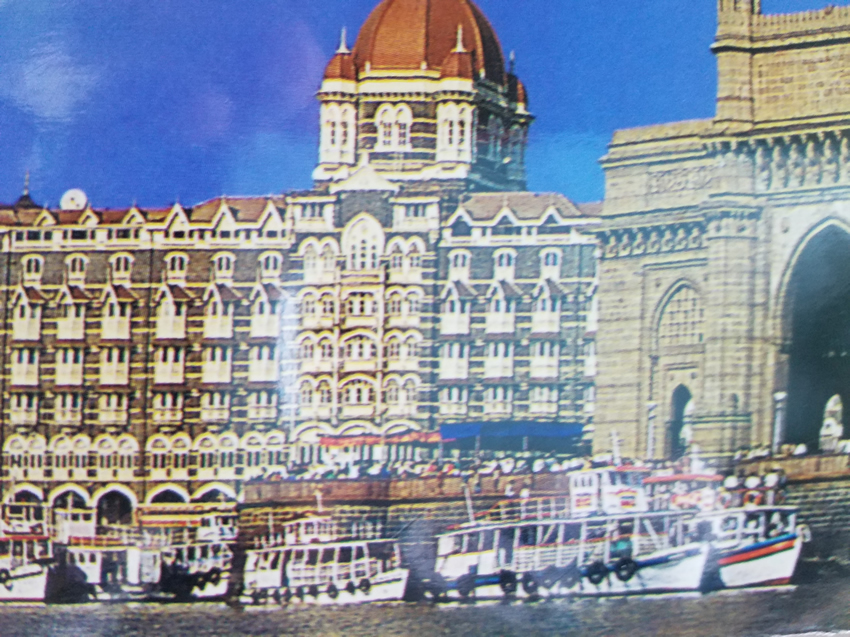
The current head of the Tata empire, a descendant of the original Tata industry founder, has built the largest house in the world. Sitting in the middle of Mumbai, it is 27 stories high and has 600 rooms. All for one family. I would not describe the building as attractive, but you can judge for yourself.
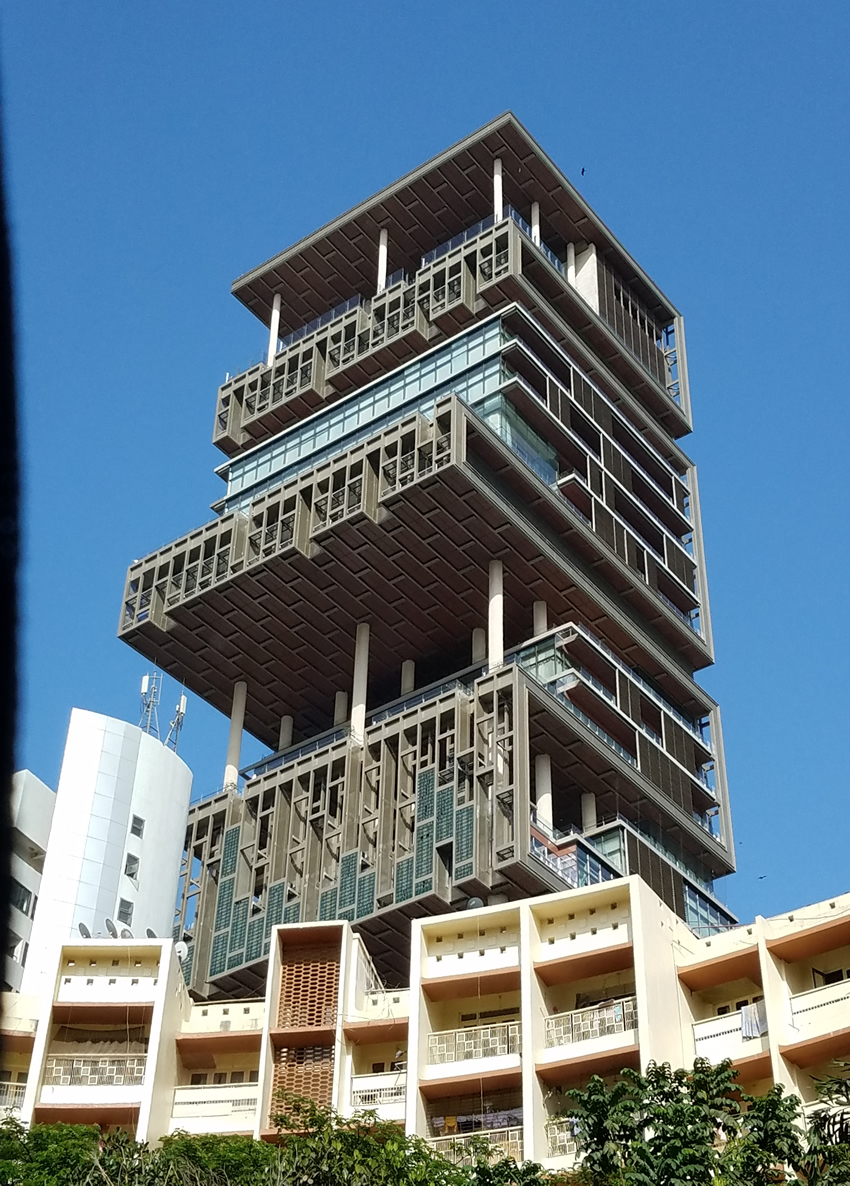
Mumbai, a mixture of decrepit building with high rises towering over them and horrendous traffic, even on Saturday. Streets in both directions, four or five theoretical lanes each, looking like a parking lot, motor scooters/cycles darting in and out and the rare pedestrian trying to cross the road.
Taxis must use natural gas and we passed one of their fueling stations where there was a line at least one block long waiting for fuiel. All the motorized two wheelers, are electric so that noise at least is minimal, but horns! The streets are a cacophony of horns plus traffic. Taxis everywhere, and private cars as well as our bus. I had to stop looking out the window. At one point a car was attempting to turn a corner as our bus was progressing and a motor scooter was trying to squeeze between them. The car backed up and the motor scooter stopped, I think…
The main streets are all very wide, and narrower side streets (like only 2 or 3 lanes) are one way. All streets are lined with shops. For a couple of stops, we had to cross the street – a real scary experience. Usually the guide led the way and we moved quickly to keep up, but not without having a few motor scooters try to stop us… As one guide said, "To cross the street you walk like a cow, hold your hand out to stop the traffic and pray." To me it was amazing that no one was hurt.
We of course had to visit the Prince of Wales Museum of Western India, renamed the Chhatrapati Shivaji Maharaji Vastu Sangrahalaya Museum (I can’t pronounce it either…) On the grounds is the head of a Buddha facing outward and in the “cave” on the other side, a reclining Buddha and many small ones lining the cave.
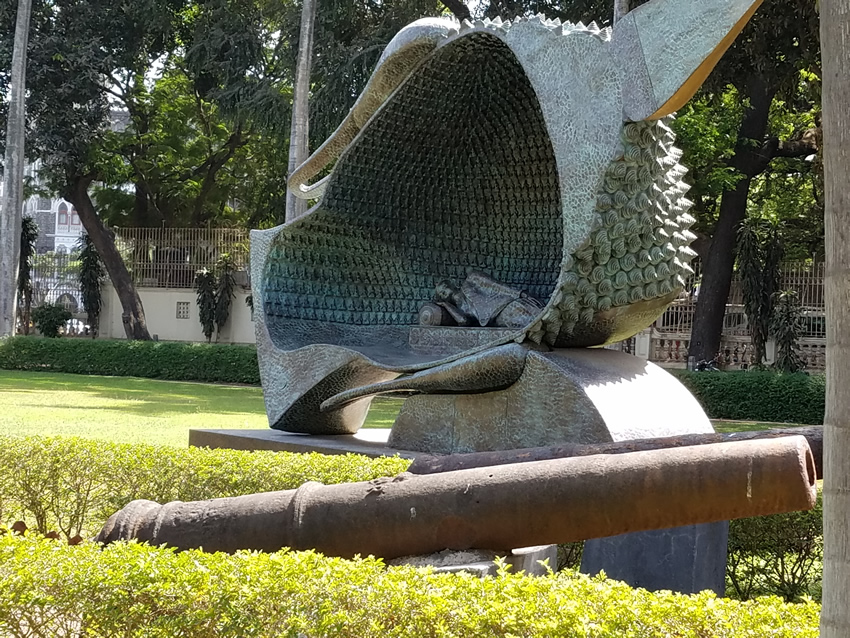
The museum is not air-conditioned, but had high ceilings and fans. Forgive me, but I don’t get a thrill of seeing old things that were a possession of some long gone sultan, but I did enjoy the small part that was the Museum of Natural History. They had an Asian elephant, which is smaller than their African brothers, and far more docile and able to be domesticated. Their color is a dark grey bordering on brown.
Below is a picture of the outside of the museum. Like so many Mumbai buildings, the architecture is breath taking.
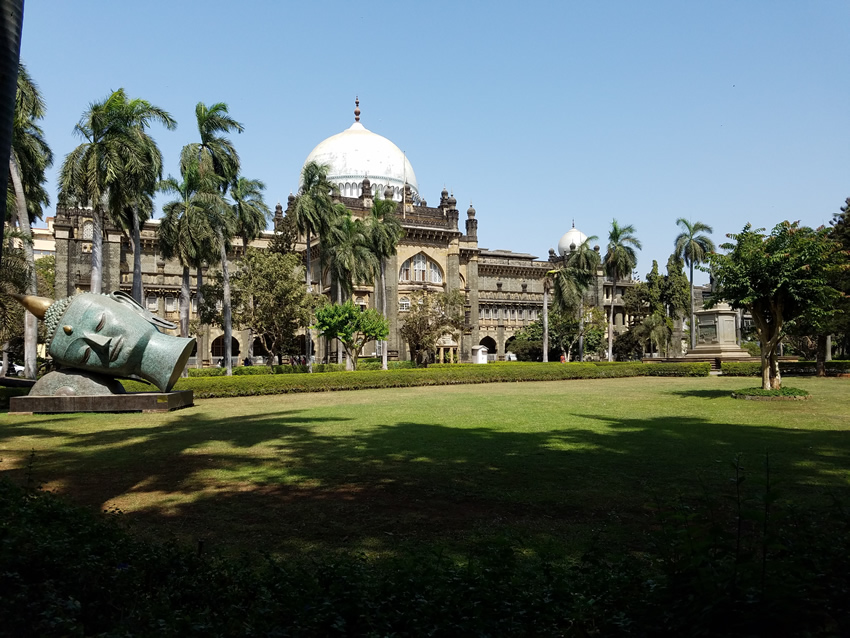
One of the quite fascinating areas for foreigners is Dhobi Ghat, a “public laundry” that has been a fixture of Mumbai for several centuries. There, in the open air, men wash cotton linens and clothing from hotels, hospitals, restaurants, and homes. Each man has his own cubicle, which are passed down from generation to generation. After boiling, washing, and rinsing, the clothes are air dried. Unless spread out on nets or bushes, they are held on the lines, not with clothes pins, but pinched between two line clothes lines. After drying the clothes are ironed by the women. How many more generations this will continue is unknown given that progress has opened more jobs, especially for those speaking English.
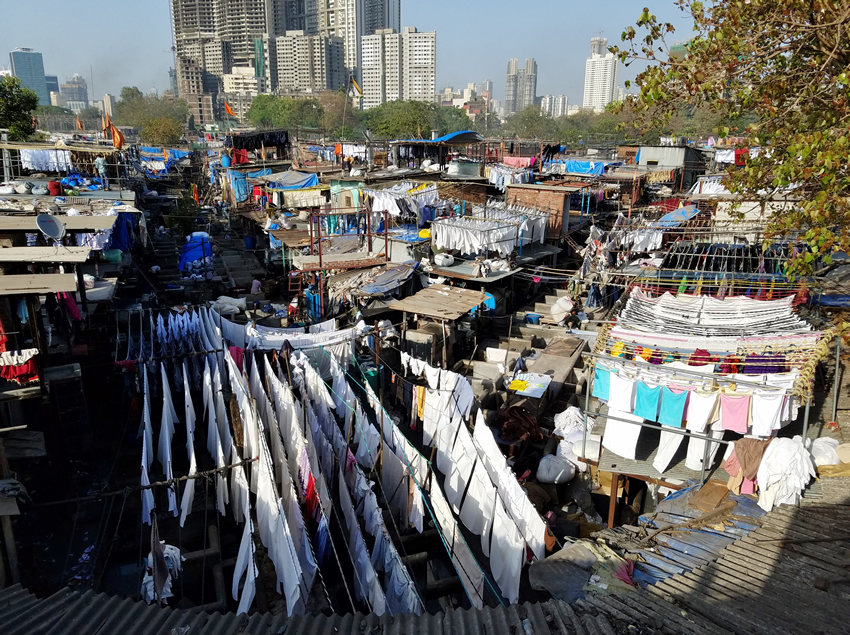
The home that Ghandi lived in while in Mumbai was our next to last visit of the day. We were by this time very late and they held it open for us. It is three stories and houses over 2,000 books, well preserved memorabilia, and the most interesting, a photo exhibit of Ghandi’s life with appropriate accompanying explanations. The exhibit included a letter which he wrote in 1962 to both Hitler and President Roosevelt asking them to stop the war.
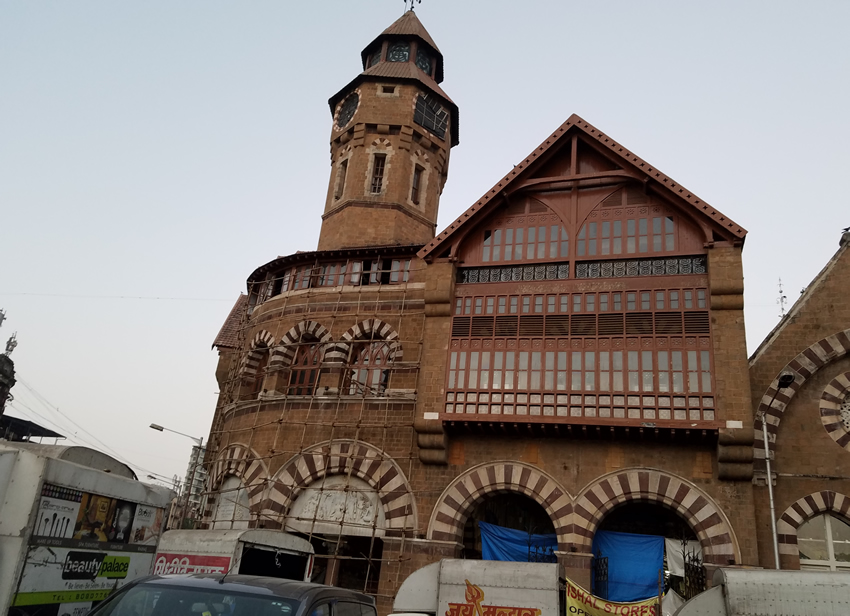
We ended the Day with a tour to Crawford Market, the outside of which is pistured above. This is a wholesale market for fruits and vegetables, but the public is also welcome. The building that houses it is from another era and you can see above. Inside, it is an experience of smells, all very pleasant, people carrying big loads, small open shops, and produce. When we first entered the odor that hit me reminded me of my uncle’s fruit barn in apple season.
The market is crowded with all kinds of people. Instead of grocery carts, there are young men who have empty, large baskets on their heads, ready to accompany a shopper and put intended purchases into the basket. And of course there are also motorcycles in there, although not for sale. Just staying out of the way of people, men carrying large boxes as well as the grocery cart men, and not stepping into water, or falling over something was a challenge. Scene below.
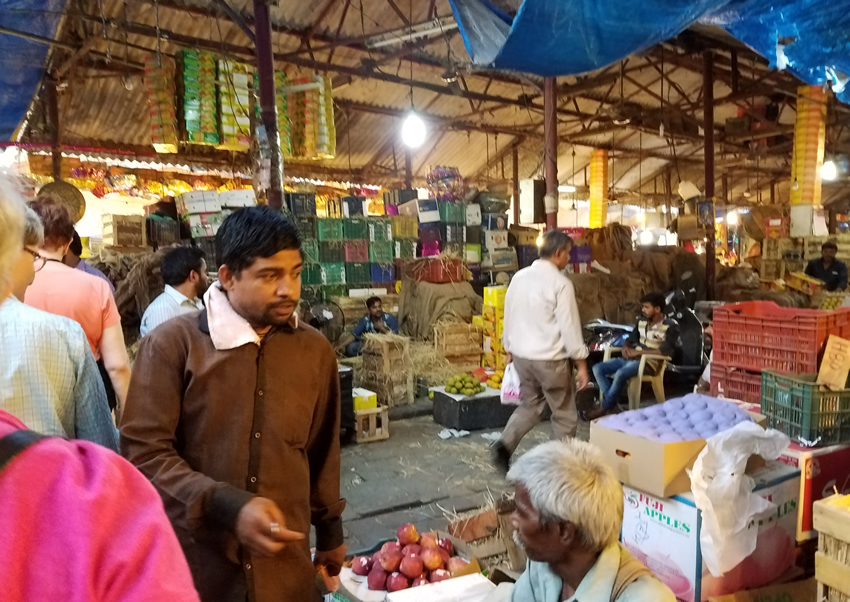
I feel badly that I have not been able to capture Mumbai in pictures, but between having a shortened tour due to immigration and experiencing most things from the bus, plus trees and the general atmosphere that is Mumbai it was impossible to represent it. In fact, I think that even a professional photographer would have trouble capturing the essence that is Mumbai.
I really wanted to capture a picture of a decrepit building with a modern high rise in the background, but was not successful, but they are very visible. I had to get the picture of this flat building - I could not believe it.
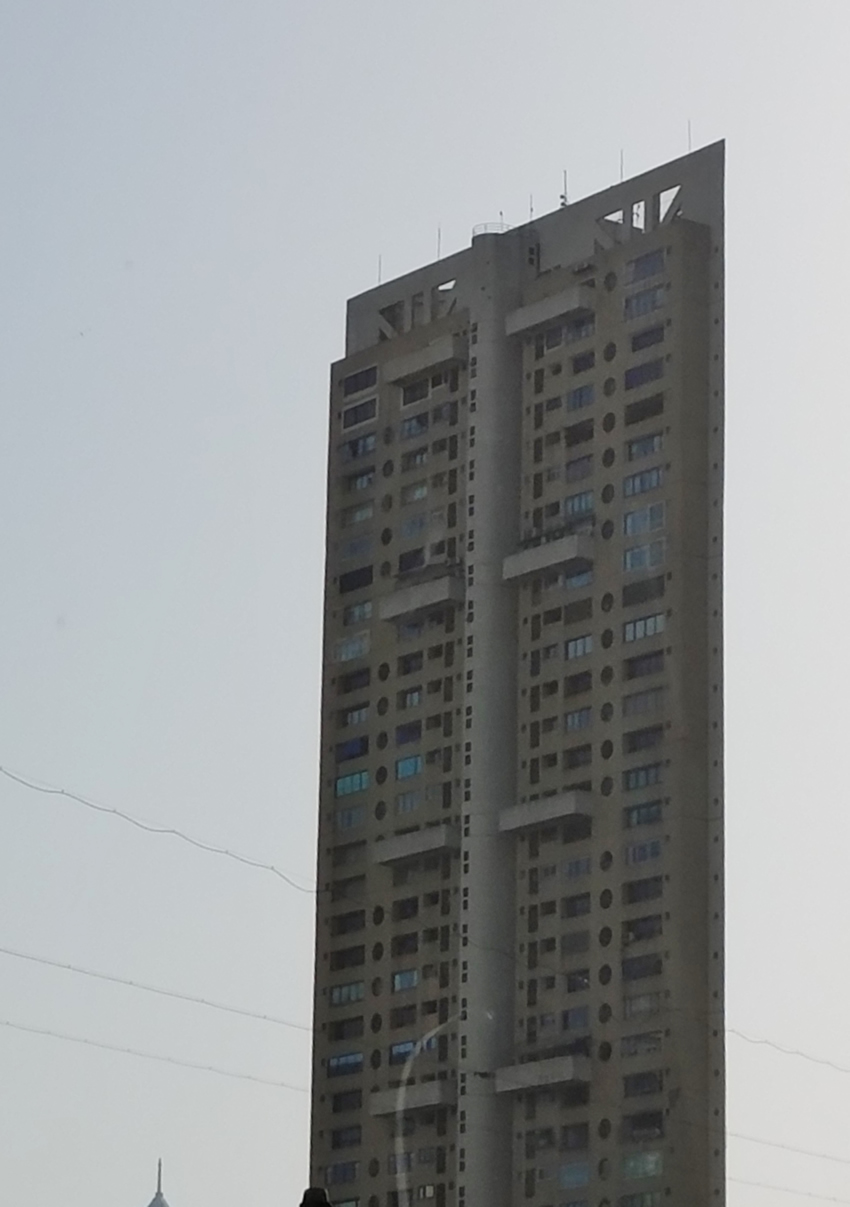
Not sitting in the window seat, I did not get a picture of the cow that was in the road as we left the ship the second day. As you know, cows are sacred in the Hindu religion. They are not legally allowed to roam the streets in Mumbai, but should one get loose, it is treated with the respect due a king. A friend took this and graciously sent it to me.

The second day tour was to the slum area, Dharavi, that I mentioned earlier. I can’t say that I was thrilled to visit there, but it is an opportunity that I would not have missed for the world. We were told that we could not take any photographs for which I am sorry. It is a slum, with two story shacks, dirt floors, and everywhere "stuff," but a very unique slum. There are no beggars, no hawkers selling junk, and no crime and we felt safe from assault or pick pockets, but had to watch our step or fall or run into someone or something. This is one of 4,000 slums in Mumbai and it sits on some very pricey real estate.
We were split into groups of 7 or 8 and assigned a guide who lived there. Our guide’s, several greats grandfather came there in 1820 when it was a forest. His family has lived there ever since. Everyone in Dharavi who is able has a job. All told they have created a $1.8 Billion a year business. Most of these involve recycling, building and maintaining the machinery needed to do this job. Youngsters gather cast off plastics, paper, cloth, aluminum, and other trash from all over the city, while others sort it, wash it, crush it, and turn it into whatever form is useful. In the case of plastic it is used in such things as luggage. They also do embroidery,and leather work (From buffalo hides, not cows).
In 90 minutes my group saw only plastic and cloth recycling, one small part of the work. Other groups saw other things. The plastic includes discarded toys, yogurt cups, plastic containers, both light and heavy, about 680 tons a day. If they were not doing this, Mumbai would soon be inundated with garbage. The work is divided into small shops; for the plastics the first stop is the sorter shop where the workers, remove paper coverings, then place it into buckets according to the weight of the plastic: light, medium, or heavy. This is done by three men sitting cross legged on the floor in a small dirt floor shop about the size of a one and a half car garage. Each bucket when full is bagged and taken to the crusher. Not only is the crusher operated by the inhabitants, but other inhabitants made the crusher. After sorting, the result is carried by other job holders, to be washed, crushed, and finally made into little pellets which are used to make other objects. American Tourister Luggage is made from items that these people have recycled. I only saw one small example of their recycling. There is a good chance that at least something you own was made from material recycled in Dharavi.
Because it sits on such valuable real estate the real estate moguls would like to tear these slums down and build high rises. They would give the inhabitants homes in new buildings, but they would lose the sense of community and companionship they now have, and worst of all, their livelihood. Fortunately, there is today, a law that for this to be accomplished 70% of the inhabitants have to approve it and they are far from getting this number. The people here want to stay. It is a community in which they are all interdependent. Hindus, Muslims, Parsi, Sikks etc. work together and respect each other’s religions. In 1992 when Mumbai suffered severe rioting between the religions, Dharavi was untouched despite tales to the contrary.
It may be the only slum in the world where people come to make a living. However, to move there, you must be sponsored. Despite all its grunginess and squalor, it is a going concern. It is not a commune, people are paid equally or according to need, but according to their skill levels. The living quarters are small, and often there is no room for a toilet, but 70% of the people have found room for one. It is beyond my comprehension and there is way more to it than I saw.
At one stop while the guide was talking to us, there was a darling little girl, about 3, who started saying hello to us and of course we responded. The guide went and picked her up and held her and she smiled at all of us. He did not know her or her family, but no one gets upset about this. I really can’t capture this area in words, it must be seen, but only with a guide, otherwise you might get lost.
All i can say about Mumbai is that it is a state or mind as well as a place. Below is a picture of some of the less than modern buildings. Note the laundry hanging outside to dry. We saw this in every country since the Pacific Islands. Even when the people have driers, such as Japan, they believe that fresh air is best for drying clothes.

Piracy
As I write this, we are underway to Oman. I am sitting in the corridor outside my stateroom in a Piracy Drill. In port yesterday, fire hoses were rigged up to use in repelling pirates. Another deterrent to boarding was a roll of razor barbed wire that was attached all around the ship on deck 3, the open deck floor. Deck 3 has the open all around deck. We are sitting because an evasive maneuver may require heeling the ship at a 25 degree angle. We are all laughing and in general enjoying this as the poor stewards go up and down the halls, stepping over our legs, checking to be sure each room is empty and placing a yellow card in the door lock if it has been checked and is empty.
Seriously, the threat of pirates is very small, and there are many warships tracking us that are out of our sight, plus several places that are tracking our movement. Plus there were hired security armed guards aboard who patrolled all the decks and there are a lot of radars being manned on the bridge. This drill is part of international maritime regulations. The captain is taking us at a high speed (24 mph – top speed is 30) to get out of what is called the “High Risk Area,” and states that we will be clear by 10:30 tonight. The real good news is that this gets us into Oman at 6P and we may get a chance to go ashore to the Souk that evening. If you are reading this you know that we are safe...
For those following the phone saga, my phone still thinks that I am in Vietnam… Oh well. Much to my surprise India, at least Mumbai is on the half hour, not the hour. Oman is 1.5 hours slower so we set clocks back 30 minutes one night and 1 hour the next.
